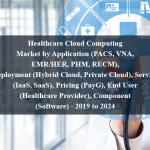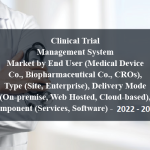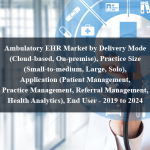OVERVIEW
The Drug Discovery Informatics Market is currently valued at USD 3.2 billion in 2024 and will be growing at a CAGR of 14.4% over the forecast period to reach an estimated USD 12.5 billion in revenue in 2029. The drug discovery informatics market represents a crucial intersection of pharmaceutical research and cutting-edge technology. It encompasses a range of computational tools, software platforms, and data analysis techniques utilized by pharmaceutical and biotechnology companies to expedite the drug discovery process. Leveraging big data analytics, artificial intelligence, and machine learning algorithms, these informatics solutions enable researchers to sift through vast datasets, predict molecular interactions, and identify potential drug candidates with higher efficiency and accuracy. By streamlining processes such as virtual screening, lead optimization, and pharmacokinetics/pharmacodynamics modeling, drug discovery informatics accelerates the identification and development of novel therapeutic agents. This market continues to evolve rapidly, driven by the increasing complexity of drug targets, the growing volume of biological data, and the imperative for pharmaceutical companies to reduce costs and shorten timelines in bringing new drugs to market.
The exponential increase in biological data generated from various sources, including genomics, proteomics, and metabolomics, necessitates advanced informatics solutions to effectively manage and analyze this wealth of information. Additionally, the rising complexity of drug targets, such as protein-protein interactions and rare diseases, demands sophisticated computational techniques for accurate prediction and modeling. Moreover, the integration of artificial intelligence and machine learning algorithms into informatics platforms enhances predictive capabilities and accelerates the identification of potential drug candidates. Furthermore, stringent regulatory requirements and the need for cost-effective drug development strategies prompt pharmaceutical companies to invest in informatics solutions that streamline processes and minimize risk. Lastly, collaborations between academia, industry, and government organizations foster innovation and drive the adoption of novel informatics technologies in drug discovery. These drivers collectively contribute to the expansion and advancement of the drug discovery informatics market.
Market Dynamics
Drivers:
The exponential increase in biological data generated from various sources, including genomics, proteomics, and metabolomics, necessitates advanced informatics solutions to effectively manage and analyze this wealth of information. Additionally, the rising complexity of drug targets, such as protein-protein interactions and rare diseases, demands sophisticated computational techniques for accurate prediction and modeling. Moreover, the integration of artificial intelligence and machine learning algorithms into informatics platforms enhances predictive capabilities and accelerates the identification of potential drug candidates. Furthermore, stringent regulatory requirements and the need for cost-effective drug development strategies prompt pharmaceutical companies to invest in informatics solutions that streamline processes and minimize risk. Lastly, collaborations between academia, industry, and government organizations foster innovation and drive the adoption of novel informatics technologies in drug discovery. These drivers collectively contribute to the expansion and advancement of the drug discovery informatics market.
Key Opportunities :
The drug discovery informatics market presents a myriad of opportunities for growth and innovation. One significant opportunity lies in the continued advancement of artificial intelligence (AI) and machine learning (ML) technologies, which have the potential to revolutionize drug discovery by enhancing predictive modeling, identifying novel drug targets, and optimizing lead compounds. Additionally, the convergence of multi-omics data integration, including genomics, proteomics, and metabolomics, offers opportunities to uncover new biological insights and identify personalized treatment approaches. Furthermore, the increasing adoption of cloud-based informatics solutions enables seamless collaboration, data sharing, and scalability, particularly beneficial for small and medium-sized enterprises. Moreover, the emergence of virtual screening platforms, coupled with high-performance computing capabilities, facilitates the rapid screening of large compound libraries, accelerating the drug discovery process. Finally, the growing focus on precision medicine and the development of targeted therapies for specific patient populations open doors for informatics solutions tailored to personalized medicine approaches. Embracing these opportunities can drive continued growth and innovation within the drug discovery informatics market.
Restraints :
One major challenge is the high upfront costs associated with implementing advanced informatics solutions, including software licenses, infrastructure setup, and skilled personnel training. This barrier to entry may deter small and medium-sized companies from adopting these technologies, limiting market penetration and innovation. Additionally, data privacy and security concerns surrounding the storage and sharing of sensitive biological and chemical information pose regulatory compliance challenges, particularly in regions with stringent data protection laws. Moreover, the complexity and interoperability issues of integrating disparate data sources and legacy systems hinder seamless data analysis and decision-making. Furthermore, the unpredictability of regulatory approval timelines and the high attrition rates in drug development add uncertainty to investment returns, deterring some stakeholders from committing resources to informatics initiatives. Overcoming these restraints requires collaborative efforts among industry players, regulatory bodies, and technology providers to address cost barriers, enhance data security measures, and streamline regulatory processes, ultimately unlocking the full potential of drug discovery informatics.
Regional Information:
• In North America, the drug discovery informatics market is characterized by robust investment in research and development, a well-established pharmaceutical industry, and a strong emphasis on technological innovation. The region benefits from a mature healthcare infrastructure, a highly skilled workforce, and favorable government initiatives supporting biomedical research and innovation. Additionally, the presence of leading informatics software providers and academic institutions fosters a collaborative ecosystem for advancing drug discovery technologies. However, the market faces challenges such as stringent regulatory requirements, rising healthcare costs, and increasing competition, which may impact market growth.
• In Europe, the drug discovery informatics market is marked by a diverse landscape of pharmaceutical companies, research organizations, and government agencies driving innovation in drug development. The region boasts a strong tradition of scientific excellence, supported by robust funding mechanisms and collaborative research networks. Furthermore, favorable regulatory frameworks and initiatives promoting open science and data sharing facilitate the adoption of informatics solutions. Nevertheless, budget constraints, fragmented healthcare systems, and regulatory complexities across different countries present challenges for market expansion and adoption of advanced informatics technologies.
• In the Asia Pacific region, the drug discovery informatics market is experiencing rapid growth fueled by expanding pharmaceutical R&D activities, increasing investments in healthcare infrastructure, and a burgeoning biotechnology sector. Countries like China, India, and South Korea are emerging as key players in drug discovery, leveraging their large population bases, growing economies, and government support for innovation. Moreover, the region benefits from a vast talent pool of skilled scientists and engineers and a growing ecosystem of startups and research institutions focused on informatics solutions. However, challenges such as regulatory harmonization, intellectual property protection, and data privacy regulations vary across countries and may impede market growth and technology adoption in some regions.
Recent Developments:
• In April 2022, Iktos, a provider of Artificial Intelligence for new drug design announced their collaboration with Teijin Pharma Limited to evolve Artificial Intelligence for small molecules drug discovery.
• In January 2022, Shanghai Fosun Pharmaceutical collaborated with Insilico Medicine for the discovery and development of drugs utilizing AI technology.
Key Market Players:
Schrödinger, Dassault Systèmes, Certara, Biovia, Genedata, CDD, Biovia, ChemAxon, OpenEye Scientific Software, and PerkinElmer
Frequently Asked Questions
1) What is the projected market value of the Drug Discovery Informatics Market?
– The Drug Discovery Informatics Market is expected to reach an estimated value of USD 12.5 billion in revenue by 2029.
2) What is the estimated CAGR of the Drug Discovery Informatics Market over the 2024 to 2029 forecast period?
– The CAGR is estimated to be 14.4% for the Drug Discovery Informatics Market over the 2024 to 2029.
3) Who are the key players in the Drug Discovery Informatics Market?
– Schrödinger, Dassault Systèmes, Certara, Biovia, Genedata, CDD, Biovia, ChemAxon, OpenEye Scientific Software, and PerkinElmer
4) What are the drivers for the Drug Discovery Informatics Market?
– The growing amount of biological data, complex drug targets, and the integration of artificial intelligence and machine learning algorithms in informatics platforms are driving the growth of the drug discovery informatics market. This is driven by regulatory requirements, cost-effective drug development strategies, and collaborations between academia, industry, and government organizations.
5) What are the restraints and challenges in the Drug Discovery Informatics Market?
– The high upfront costs of implementing advanced informatics solutions, data privacy and security concerns, and regulatory compliance issues hinder small and medium-sized companies from adopting these technologies. The complexity of integrating disparate data sources and legacy systems, as well as the uncertainty of regulatory approval timelines and high attrition rates, require collaboration among industry players, regulatory bodies, and technology providers.
6) What are the key applications and offerings of the Drug Discovery Informatics Market?
– Key applications of drug discovery informatics include virtual screening, molecular modeling, lead optimization, and pharmacokinetics/pharmacodynamics (PK/PD) modeling. Virtual screening utilizes computational methods to identify potential drug candidates from large compound libraries, reducing the time and cost of experimental screening. Molecular modeling techniques, such as molecular dynamics simulations and structure-based drug design, aid in understanding molecular interactions and predicting ligand-receptor binding affinities. Lead optimization involves refining and improving initial hits into drug candidates with desired properties through computational methods, accelerating the drug development process.
7) Which region is expected to drive the market for the forecast period?
– North America is expected to have the highest market growth from 2024 to 2029
Why Choose Us?
Insights into Market Trends: Global Market Studies reports provide valuable insights into market trends, including market size, segmentation, growth drivers, and market dynamics. This information helps clients make strategic decisions, such as product development, market positioning, and marketing strategies.
Competitor Analysis: Our reports provide detailed information about competitors, including their market share, product offerings, pricing, and competitive strategies. This data can be used to inform competitive strategies and to identify opportunities for growth and expansion.
Industry Forecasts: Our reports provide industry forecasts, which will inform your business strategies, such as investment decisions, production planning, and workforce planning. These forecasts can help you to prepare for future trends and to take advantage of growth opportunities.
Access to Industry Experts: Our solutions include contributions from industry experts, including analysts, consultants, and subject matter experts. This access to expert insights can be valuable for you to understand the market.
Time and Cost Savings: Our team at Global Market Studies can save you time and reduce the cost of conducting market research by providing comprehensive and up-to-date information in a single report, avoiding the need for additional market research efforts.












